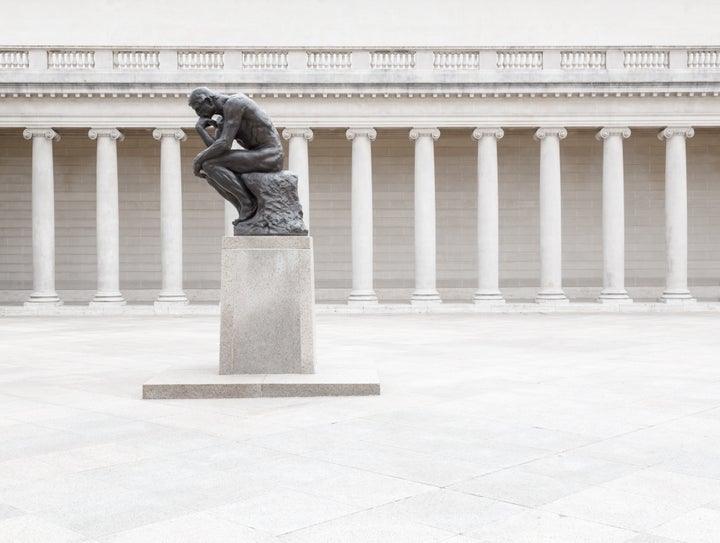
The first time I saw Rodin's The Thinker I was nine, at the Museum of Western Art in Tokyo. It was a small, unassuming bronze cast in a room of eye-catching paintings, but there was something powerful about it. A sense that as we gallery visitors contemplated the thinker, he contemplated something beyond us. I've forgotten a lot of things about that trip, but I remember The Thinker, especially the way it pulled its viewers in and stopped them.
I say the first time, because I saw a much larger cast of The Thinker ten years later in Paris. It's a powerful feeling to come back to the same sculpture ten years later -- like coming back to your hometown after years of absence and change. For me, there's something about the work of certain familiar artists that's like coming across an old friend, or a childhood memento. When I think of my favorite paintings, it's not just that they're aesthetically beautiful, or artistically appealing -- they're linked to a series of past experiences and a dense network of memories. I'm sure we all have artists whose work makes us feel this way. Standing in the garden of the Musée Rodin, facing The Thinker once again, a lot of thoughts were running through my head: nostalgia for that trip to Tokyo 10 years ago, appreciation for the beauty of the sculpture in front of me, and naturally, as a cognitive science student, curiosity about why we make such strong connections with art.
Our experiences of art are so subjective that studying them in a scientific way seems impossible, but a growing field called neuroaesthetics is attempting to do just that. While much of neuroaesthetics deals with the visual and perceptual processing of art, that's not where the field stops -- imaging studies are revealing a plethora of brain regions activated when we experience art. Not only are visual and perceptual processes involved, but also reward pathways and areas of the brain like the prefrontal cortex, which are involved in evaluative judgments.
The prefrontal cortex's role in experiencing art isn't surprising -- it's involved in many aspects of higher-order cognition, like decision-making as well as planning and moderating complex behaviors. Regions of the prefrontal cortex have been implicated in both aesthetic judgments and the aesthetic emotional experience. Our response to art always has an element of appraisal that has to do not only with a work's visual properties, but also with the context it's presented in and our knowledge of its history. This is especially noticeable in modern and contemporary art. Think of Duchamp's readymades, or Warhol's Brillo boxes -- their appeal has nothing to do with their aesthetic beauty, but rather comes from an understanding of the artist's message and intentions, the amount of effort that we believe went into the piece, and other aspects of the work's causal history. This is why we value originals over forgeries and why pieces like Duchamp's readymades can still have artistic merit. Neuroaesthetics -- as evident from even its name -- often overlooks the fact that art does not have to be beautiful: context and history play a crucial role in our judgments.
What is surprising is that experiencing art -- something that, at a basic level, is purely visual -- is rewarding to the brain. This ties into another question that neuroaesthetics is trying to find answers for: whether art has an evolutionarily adaptive value. Some believe that art has an adaptive social value as a form of communication and an aesthetic appeal linked to attractiveness and mate selection. Others, like Kant, view aesthetic pleasure as "disinterested" -- self-contained and distinct from any drives or desires. It's possible that the neural circuitry associated with rewarding stimuli we have a "disinterested interest" in, like art, is distinct from reward systems that serve the clearly adaptive value of fulfilling drives like hunger or thirst.
While these findings are interesting, the question of whether art can really be reduced to a neurobiological explanation remains -- what does neuroaesthetics or evolutionary theory really explain about the powerful, sometimes sublime effect art can have on us? Our experience of art is more than evaluative or even rewarding -- it can be transformative and defining. The art that's important to us says something about our personality, our taste, and our past. When I think of Monet's paintings it's not just their visual beauty or my knowledge of their history that comes to mind -- it's my history: a collection of memories from seeing his work in seven countries across three continents and over at least ten years. Both historical and psychological/neuroscientific frameworks have yet to address that the associations we make with art aren't just about the work's history or our knowledge of the artist, but about our personal history. How far neuroaesthetics can take us in understanding our experiences of art remains to be seen, but the field presents a ground on which art and science can converge.